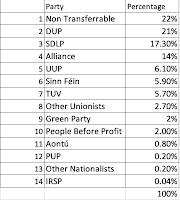A brief look at the size of Northern Ireland’s new constituencies ahead of the July 2024 General Election.
The General Election on 4th May 2024 will be the first time we go to the polls the new constituency boundaries in place. Constituency boundaries were changed to make the UK’s electoral boundaries more equal in size. Each constituency must fall with the range of 69,724 – 77,062 voters due to the Uk average constituency size across 645 (not 650) constituencies is 73,393, so a 5% margin either side of this figure. Between England and Scotland 5 constituencies are exempt from this rule due to geographical reasons (Scottish Islands, Isle of Wight etc.) Northern Ireland was also granted a further 5% margin due to geographical constraints with more than half the constituencies either bordering the Republic of Ireland or the sea, however the commission did not need to use this extra leeway, opting instead to split some wards.*
The boundary commission review used the electoral register from 2nd March 2022 and since then (as of May 2024) Northern Ireland has added 55,673 voters. Some constituencies have already passed that 77,062 upper limit. Unfortunately I cannot find any up to date figures to check if these constituencies would meet the guidelines if they were using May 2024’s register to create the boundaries.
The largest constituency in Northern Ireland is Lagan Vally with Upper Bann not far behind, both constituencies have over 80,000 registered voters. The smallest constituency is Belfast East with just under 72,000 registered voters. Lagan Valley and South Antrim have been the fastest growing constituencies, both increasing in size by 6.4%, both added over 4,500 new voters. No constituency has decreased in size but the slowest growing was Belfast South and Mid Down adding just 2.1% with Belfast East (2.7%) and Belfast North (3.1%) rounding off the bottom three.

Electoral boundaries by size May 2024 
Electoral boundaries by % change from March 2020 to May 2024
These figures do not give us any indication as to how these constituencies may vote. Northern Ireland managed to avoid radical change with only minor tweaks, in most cases the boundary changes seem to favour the current incumbent or at least do not significantly benefit a realistic challenger, the real changes may be felt in an Assembly election with the final seats being competitive in many constituencies.
These figures are important though, the latest boundary commission review was tasked with creating more equal sized constituencies, Northern Ireland has already shown signs that these new boundaries may not be fit for that purpose for very long. This is not of course, the fault of the boundary commission, they cannot be expected to account for potential geographic population shifts. We can see the Belfast constituencies growing at a slower pace than their neighbours in the suburbs with some rural constituencies also making the top half. It is impossible to always have equal sized constituencies, but at some stage it becomes difficult to justify the size difference (on the old boundaries Upper Bann grew to have around 18,000 more voters than East Antrim) and equal representation is critical for trust in democracy. More voters will be added in the coming weeks but there will be no radical changes.
I hope to have something written in the coming weeks about which constituencies will be worth paying close attention to on election night, though an early look leads me to believe most incumbents should be safe enough.
A July election means many people may be in holiday. Be sure to take the opportunity to apply for a postal vote if this may effect you. You can for a postal vote apply here.
*The split of the ‘Strangford” Ward was very strange with just 30 (now up to 45) voters being left in South Down with around 3,000 moving to Strangford.



Comments
Post a Comment